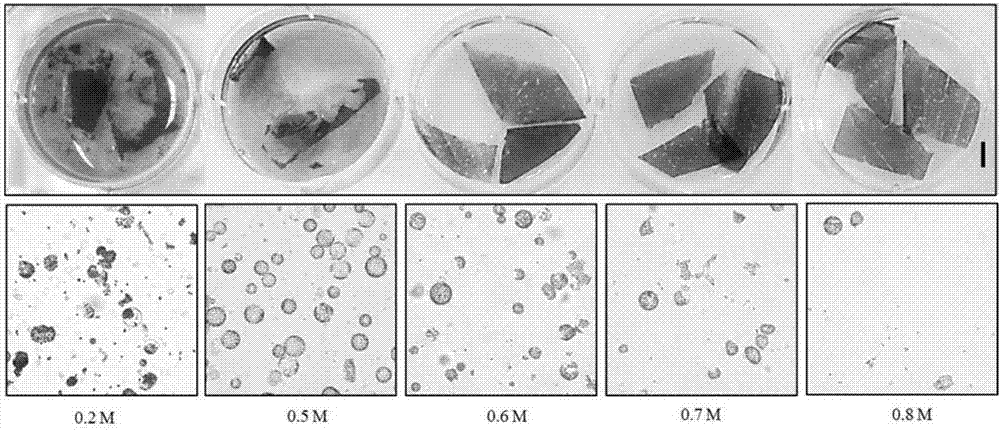Method for separating and converting rape protoplast
A technology of protoplasts and rapeseed, applied in the field of plant genetic engineering, can solve problems affecting the progress of rapeseed scientific research, achieve the effects of improving scientific research work efficiency, reducing experimental costs, and shortening the experimental cycle
- Summary
- Abstract
- Description
- Claims
- Application Information
AI Technical Summary
Problems solved by technology
Method used
Image
Examples
Embodiment 1
[0025] Example 1 Effect of Enzymolysis Solution and Enzymolysis Time on Rapeseed Protoplast Isolation
[0026] The key to the successful separation of protoplasts is the enzyme used to enzymatically hydrolyze the cell wall. We set up two enzymatic hydrolysis solutions to compare the yield and quality of protoplasts under different enzyme concentrations. The specific methods are as follows:
[0027] The first group: enzymatic hydrolysis solution is prepared at the enzyme concentration commonly used for plant protoplast separation, and the enzymolysis solution contains 1.5wt% cellulase, 0.4wt% isolated enzyme, 0.5M mannitol, 20mM KCl, 20mM MES (pH, 5.7), 10mM CaCl 2 , 0.1wt% BSA;
[0028] The second group: 1wt% cellulase, 0.3wt% resolase, 0.5M mannitol, 20mM KCl, 20mM MES (pH, 5.7), 10mM CaCl 2 , 0.1wt% BSA;
[0029] The results showed that after 3 hours of enzymolysis, the protoplast output of the first group of treatments was (4 ± 0.2) × 10 5 per gram of leaves, the second...
Embodiment 2
[0036] Example 2 Transient expression of yellow fluorescent protein in rapeseed protoplasts
[0037] The solution used consisted of the following:
[0038] Enzyme solution: 1wt% cellulase, 0.3wt% isolated enzyme, 0.5M mannitol, 20mM KCl, 20mM MES (pH5.7), 10mM CaCl 2 , 0.1%wtBSA, ready to use;
[0039] W5 solution: 4mM MES, 154mM NaCl, 125mM CaCl 2 , 5mM KCl, 2mM MES (pH 5.7);
[0040] MMG solution: 0.4M mannitol, 15mM MgCl 2 and 4mM MES (pH 5.7).
[0041] 1. Separation and purification method of protoplasts
[0042] (1) Select rapeseed true leaves or 3-5 pieces of rapeseed cotyledons that have grown for about 2 weeks (the cotyledons can be obtained after 7 days of germination, the cultivation environment and technology are simple, easy to obtain, and greatly shorten the experimental cycle), and fix both ends of a piece of tape On the table, with the sticky side up, stick the leaves or cotyledons on the tape with the lower cuticle facing up, then tape the lower cuticle, ...
Embodiment 3
[0055] Transient expression of embodiment three reporter genes LUC and Ren in rape protoplasts
[0056] 1. Separation and purification of protoplasts
[0057] The same as the separation and purification method of protoplasts in Example 2.
[0058] 2. The method for transient transformation of rapeseed protoplasts mediated by PEG
[0059] Expression vector plasmid preparation: the vector used is pGreenII 0800-35S-LUC, and the vector map is as follows: Figure 6 As shown, the plasmid was extracted using the Tiangen Endotoxin Free Plasmid Extraction Kit, operated according to the instructions, and the concentration of the extracted plasmid was adjusted to about 1 μg / μL for later use.
[0060] (1) Add 10 μg plasmid DNA (1 μg / μL) to 200 μL protoplast-MMG suspension, flick the bottom of the tube to mix;
[0061] (2) Add 220 μL 40% PEG-4000, flick the bottom of the tube to mix, and place at room temperature for 15 minutes;
[0062] (3) Add 880 μL W5 solution to re-suspend, flick ...
PUM
 Login to View More
Login to View More Abstract
Description
Claims
Application Information
 Login to View More
Login to View More - R&D
- Intellectual Property
- Life Sciences
- Materials
- Tech Scout
- Unparalleled Data Quality
- Higher Quality Content
- 60% Fewer Hallucinations
Browse by: Latest US Patents, China's latest patents, Technical Efficacy Thesaurus, Application Domain, Technology Topic, Popular Technical Reports.
© 2025 PatSnap. All rights reserved.Legal|Privacy policy|Modern Slavery Act Transparency Statement|Sitemap|About US| Contact US: help@patsnap.com



